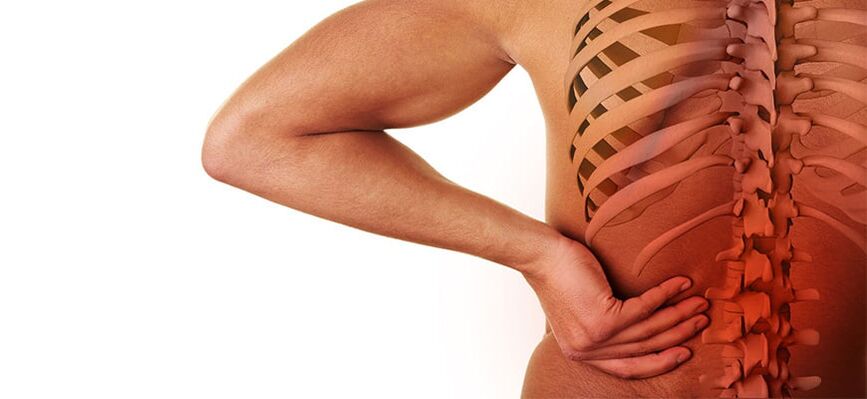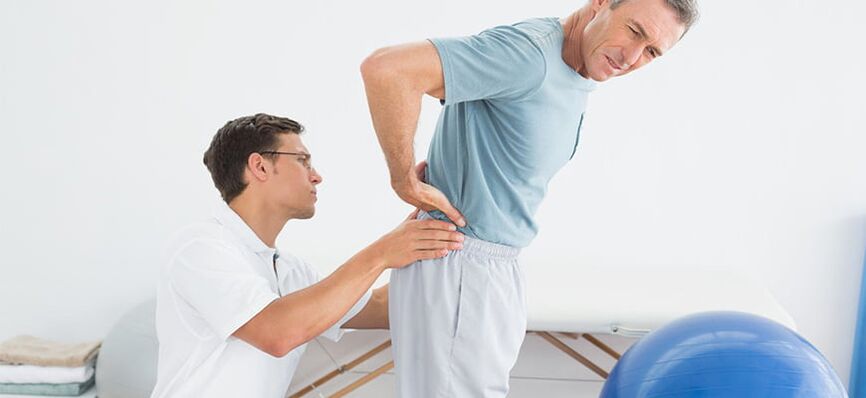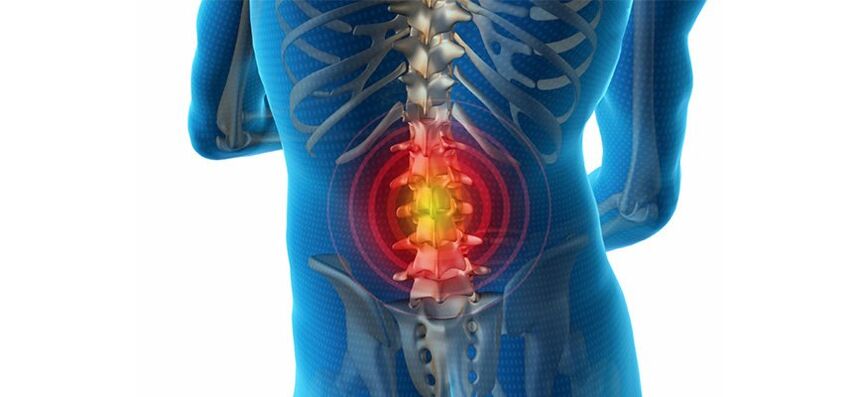Osteochondrosis of the lumbosacral spine is a disease with rather pronounced symptoms, which manifests itself in the later stages of the development of the disease. Pathological changes begin in the intervertebral discs, but then spread to other parts - joints, ligaments and vertebral bodies. Lumbosacral osteochondrosis rarely occurs in young people, its symptoms and treatment are always strictly individual, depending on the specific clinical case. However, there are several specific symptoms that can be used to diagnose this pathology. It is extremely important to recognize the disease at an early stage in order to exclude the possibility of complete destruction of the intervertebral disc and surgical intervention.

Typical symptoms of back pain
Osteochondrosis of the lumbosacral spine leads to gradual destruction of the disc, which is why it is characterized by rather vivid symptoms. The most common manifestations are:- Intense pain localized in the lumbar region.
- A feeling of fullness and stiffness.
- The pain can be shooting and can be localized along the entire length of the lower limbs.
- Numbness in the back and legs.
There are other less obvious signs of osteochondrosis of the lumbosacral spine. The anatomical features of the structure of the female body influence the manifestations of this disease, which are somewhat different from the symptoms of men. In addition to pain, the following symptoms can be observed:
- Difficulty urinating.
- Frequent urge to empty the bladder.
- Aggravation of diseases of the urogenital system.
The main features of the pathology of the disease in osteochondrosis

Osteochondrosis of the lumbar sacral spine is an extremely dangerous disease, so it is important to know its symptoms and treatment, which prevents surgery. This disease has the following characteristics:
- This type of pathology is the most common among all types of osteochondrosis. It is diagnosed in about 65% of all registered cases.
- There is a clear connection between this disease and the natural changes associated with age. Statistics show that after 70 years, almost 80% of people suffer from the manifestations of this disease.
- The disease can appear at a much younger age. The risk group includes those who perform intensive physical work or who are in a monotonous position for a long time.
- The cause of osteochondrosis can be a congenital disorder, as well as various provoking factors.
Causes of spinal disease

Before answering the treatment of lumbosacral osteochondrosis, it is important to know the main reasons that influenced the progression of the pathological process:
- Overweight. Overweight people are at risk because their excess weight puts increased pressure on their spine.
- Back injuries and injuries.
- Passive lifestyle. There is also a certain list of professions whose representatives suffer from this disease more often - these are drivers, office workers and other types of work characterized by long-term exposure to the same positions.
- Lifting heavy objects and loads. There are certain rules, if not followed, this disease can develop.
- Frequent stress on the back. They can be related not only to a person's professional activities, but also to sports.
- Eating inappropriate foods. If the diet lacks nutritional elements that are important for normalizing metabolic processes and improving bone structure, the disease progresses. That is why diet is one method of complex therapy.
- Genetic factors.
- Hypothermia of the body.
- Low physical activity of a person.
- Flat feet and scoliosis.
The loss of elasticity of the intervertebral discs can be caused by various diseases of the cardiovascular system and infectious diseases.
Sacral-lumbar osteochondrosis
The main stages of the disease:
There is a clear tendency to significantly worsen the clinical picture if the appropriate treatment is not started in time. The severity of the symptoms depends on the stage of the disease, of which there are only four:
- First phase. In the early stages, there is pain, which occurs under the influence of various loads. This condition is characterized by lumbodynia and lumbago, which are certain types of pain that can be steady or shooting.
- Second stage. There is a violation of the stability of the intervertebral disc, which leads to muscle spasms. The structure of the fibrous ring is destroyed, the gelatinous content protrudes. The pain syndrome becomes more constant and pronounced.
- Third stage. Disc prolapse leading to pinched nerves. This condition leads to severe back and leg pain, loss of sensitivity, dysfunction of the pelvic organs and muscle atrophy.
- Fourth stage. Bone growth of lesions and changes in the structure of the spine are diagnosed at this stage. It becomes much more difficult for the patient to move, the pain becomes constant and unbearable, which may lead to complete disability in the future.
Methods of diagnosing back diseases

The treatment of osteochondrosis of the lumbosacral spine is based on establishing an accurate diagnosis. If you notice the first symptoms of the disease, immediately consult a doctor for appropriate help, which will help to avoid the worsening of the condition. The establishment of the diagnosis begins with the preliminary taking of the anamnesis, and then the patient is prescribed a number of diagnostic measures:
- X-ray examination. With its help, you can assess the condition of the vertebrae for the presence of anomalies. A decrease in the height of the intervertebral discs, the identification of osteophytes and a narrowing of the space between the joints can be seen.
- CT scan. It allows the condition of the structure of the entire spine and its individual components. It allows to determine the stage of the disease and the presence of pathology of bone structures.
- MRI. This method is the most informative of the above. With its help, you can see the intervertebral hernia, determine the compression of the nerve roots and other pathologies. If this diagnostic method is contraindicated for the patient, CT should be used.
In order to clarify the diagnosis, consultation with specialists may also be justified.
The main methods of treating the lumbosacral spine
If you want to know how to treat osteochondrosis of the lumbosacral spine, then the following information will be useful. This pathology is characterized by a gradual course of the disease, which can be replaced by periods of remission and exacerbation. Initially, you need to get rid of pain and relieve the inflammatory process. Appropriate drug therapy is used for these purposes using modern injectable and oral agents. The first category of drugs is used when you need to quickly get rid of severe pain. As for oral medications, non-steroidal anti-inflammatory drugs are used. The above medicines relieve pain of different intensity well. Medicines from other groups are also effective in the treatment of the disease:
- Chondroprotectors. They have a positive effect on cartilage tissue and promote regeneration processes.
- Muscle relaxants. Their goal is to get rid of muscle spasms.
- External devices. Creams, gels and ointments are aimed at eliminating the severe symptoms of the disease, but their effectiveness is not as high as that of injectable and oral agents.
Physiotherapy
Treatment of lumbar osteochondrosis is a long processrequires an integrated approach. After getting rid of the primary symptoms, you can continue using various physiotherapy procedures:
- UHF therapy.Exposure to high frequency electromagnetic fields. It has an anti-inflammatory and pain-relieving effect, and also promotes the initiation of regeneration processes.
- Amplipulse.Low-frequency currents are applied to problem areas of the body. Blood vessels dilate, relieving pain and spasms.
- Phonophoresis and electrophoresis.Introduction of drugs into deep tissues using ultrasound and direct current.
Massage procedures are also widely used, which are possible only after the inflammatory process subsides. Massage helps to relax the muscles and relieves cramps.
Diet - comprehensive treatment of osteochondrosis
This disease needs to be dealt with comprehensively, so changing the diet is a completely effective method of treatment. The diet is in line with the generally accepted concept of healthy eating, so try adding the following types of foods to your diet:
- Citrus fruits (in the absence of allergy).
- Olive oil.
- Fresh herbs and vegetables.
- Mineral water.
- Fish and foods high in phosphorus, protein, magnesium and calcium.
- Milk and fermented milk products.
Ready-made vitamin complexes, which can be found in a large selection in pharmacy chains, are an excellent help. Remember that all medicines should be taken only as prescribed by the doctor.
Ways to prevent back pain
Everyone knows that preventing a disease is much easier than treating it and getting rid of its consequences. Moreover, effective preventive measures are quite easy to implement in practice if you really want to. The main recommendations are:

- Proper organization of the workplace.Watch your body position, try to avoid uncomfortable situations. If you spend a lot of time in front of the computer, buy a comfortable chair with a backrest that supports your spine.
- Take a break from work.Get up from your seat more often, warm up your body with regular body turns. Squatting and bending are also helpful.
- It normalizes your day.First of all, we are talking about rest, so try to go to bed early, excluding prolonged sitting in front of the computer. It is important to choose a suitable orthopedic mattress that supports your spine while you sleep.
- Get rid of bad habits.
- Avoid vigorous exercise and heavy lifting.Swimming, yoga and regular walks in the fresh air are excellent alternatives.
Conclusion:
Now you know how to treat osteochondrosis of the lumbosacral region without surgical intervention. Surgery is the most radical treatment method when the disease has advanced and there is no other way out. But it is within your power to ensure that your health does not deteriorate to such a state.



















